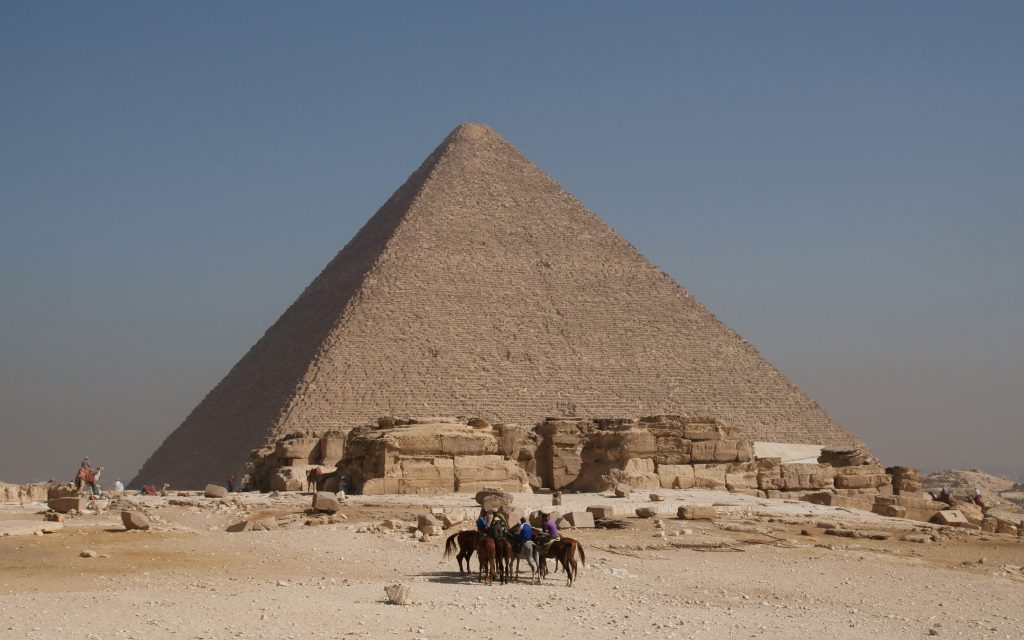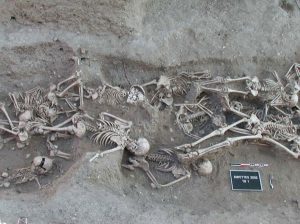I think that it is a given that humans have a bit of a fascination with death and everything that comes after, that is, if one even believes that there is anything that comes after death. In fact, one can find that this fascination can even be seen in ancient human societies, and of all of them there is none that shows more fascination with the dead than the great society of ancient Egypt, which built great monuments and sculptures to the dead, wrote guides for the dead to use on their journey through the afterlife, and mummified bodies so that the “Ka,” which was their concept of the soul, could travel and exist in the afterlife.

One of the most well known things about the ancient Egyptians are their mummies; but what exactly are mummies? They are not the man killing monsters that Hollywood films have come to portray them as, but are rather simply the preserved and mummified remains of a person. This leads us to the next question: why mummify the dead? The reason the dead where mummified is simple: without the body, the Ka cannot exist and the Ka is what allows one to travel and live in the afterlife.
The Ka itself is very much like the Christian concept of the soul, which is believed to go either to heaven or hell after death.1 According to Egyptian culture and religion, the Ka is the spirit-body. However, in order for it to exist, it must also have a physical body. So to insure that the dead would be able to go to the afterlife, the body was mummified so that it might stay behind as the Ka moved on to the afterlife.
While the Egyptians mummified the bodies to be sure that the Ka had a physical form in which it could reside, there was still an issue: tomb raiders. Tomb raiders plundered tombs and took the bodies of the dead, or defiled them, causing the Ka to become separated from its physical form. It is important to keep in mind that this was not really an issue for the poor members of society, but for the elite and pharaohs of ancient Egypt this was quite important.2
It is for this reason that the high elite of Egyptian society—mostly the pharaohs—had statues made and sculpted in their image. They believed that, if their tomb was raided and something happened to their body, the Ka simply moved from the body to the statue, which became the new physical form in which the Ka resided.3
Egyptian funerary texts are another aspect of the Egyptian culture that exhibits a fascination for the dead in ancient Egyptian culture. The funerary texts, called “Per en Bru” by the Egyptians, roughly translates to the Coming of Days. The texts themselves were very unique, each created with the intent of helping the deceased travel through the afterlife.4 In a sense, funerary texts were a kind of general guide or handbook, which consisted of a multitude of spells and information on the afterlife that was believed to help the Ka on its way to the new life.

Another thing that shows how fascinated the Egyptians were with the dead can be found in urns and canopic jars. It was not until the first explorations of the Egyptian tombs that archaeologist came to find the canopic jars, and it was not until they were opened that archaeologists learned that within these jars were the preserved organs of the dead.5 It was only due to the discovery of the funerary texts that archaeologists learned the reason for this. What was learned was that the organs were placed into the jars so that the Ka would be able to take them to the afterlife. However, not all organs were preserved in these jars, and not all of the ones that were preserved served a practical use. One example of this is the heart. In fact, the funerary texts detail how the Ka would carry the heart to Anubis, who would then place it on a scale to be weighed against a feather of Ra. Once place on the scale, the trial of judgement would begin; now there are some important things to know about this trial; first, the feather of Ra symbolizes purity and perfection; second, the heart represents the soul or Ka, so when the heart was placed on the scale, if it weighed more than the feather, that meant that the Ka was not pure, and Anubis would have his beast devour the heart, thus erasing the Ka. However, if the heart weighed less than the feather, that meant that the Ka was pure and could move on to its new live in the afterlife.
- Erik Hornung, The Ancient Egyptian Books of the Afterlife, David Lorton, translator (Cornell University Press, 1999), 154. ↵
- Jan Assmann, Death and Salvation in Ancient Egypt (Cornell University Press, 2005), 105. ↵
- Henri Frankfort, Ancient Egyptian Religion: An Interpretation (Courier Corporation, 2012), 96. ↵
- John H. Taylor, Death and the Afterlife in Ancient Egypt (University of Chicago Press, 2001), 196. ↵
- Ann Rosalie David, Handbook to Life in Ancient Egypt (London: Oxford University Press, 1999), 152. ↵



87 comments
Nicolas McKay
Great article, Jacob. You did great at explaining each of he Egyptians beliefs on the subject of death with great detail. You are right when you say they certainly had a fascination with death and the afterlife, but I believe many other cultures do as well. It is human nature for people to wonder what lies beyond the physical life that we know, and even though we do not have as many traditions and taboos as they once did, I believe we are still equally as fascinated.
Alyssa Vela
I’m not going to lie, I was a little apprehensive to continue the article after the first paragraph for the sole reason that it was written in first person. Initially I didn’t think an article would sound like an article if it were written in first person, but I was wrong! I loved how you integrated your opinion into your article, not many people are able to get away with letting their readers know their stance on a subject all the while staying professional. The amount of research put into mummification was shown, by how much detail was put into it! Overall this was an amazing article! Thank you for proving me wrong!
Zaraly Frasquillo
I remember in third grade learning about King Tut, and my fascination for Egyptian mummies grew immensely. Your article was so easy to read and I loved that you wrote it in first person (not many people can write in first person and sound professional, you can!) I never knew about the “Ka”, so learning about it made me understand why they mummified the bodies. I think it is crazy how people back then would steal from the dead. Honestly Jacob I learned a lot from your article, great job dude!
Mariana Govea
Great article! I enjoyed reading it! Very well organized and explained! This topic of mummies is so interesting! And learning of why they did it and how they did it and about their beliefs is so astonishing! Its so fascinating to know about all of their beliefs even though they have a similar beliefs that as us that either a soul can go to heaven or hell, its so crazy to know the strategies and practices that they used to do to help the soul reach whatever place it was that they were going to!As well as you did a great job or laying out the information about how the process worked very smoothly and made it easy to comprehend! Great read!
Aimee Trevino
I loved this article! I really liked the way you describe the importance of everything the process of mummification. It is interesting to see how Hollywood version of mummies are portrayed, and have really nothing to do with the true meaning of mummifying. I also really liked that you used your personal input on to the article, it gave it more significance. Great job!
Alejandro Garza
I always love reading about how different cultures and religions care for their dead and their concept of an afterlife. In particular i liked their concept of the “weighing of the heart” and depending on whether or not it weighed more than the feather would determine the fate of their Ka. Other religions also share similar concepts to the weighing of the heart when deciding the fate of an individual in the afterlife.
Samuel Sanchez
Great article! I never knew the reason behind the mummification. I did not know how important the body was for the Egyptians in the afterlife. It was interesting to get an insight on why the heart was not preserved unlike the organs. For the heart to be judged by its weight compared to a feather in order for the person to have access to the afterlife. That’s crazy. Keep up the good work.
Bailey Rider
I loved reading this article! As a child, I loved learning about mummies and I was fascinated with the mummification process. My Girl Scout troop even “mummified” our barbie dolls. I never knew the reason that the bodies were mummified though. Learning about the Ka, or soul was really neat. I could see how the body would need to be preserved if the Ka could only continue with a physical body. I also thought it was really neat how Pharaohs had large statues made just in case their tomb was defiled so their Ka could jump into the statue. Thank you for such a wonderful article!
Nahim Rancharan
It is no secret that the ancient Egyptian culture is one of the most studied cultures in history. Given the fact that the Egyptian culture was temporarily lost for several years, archaeologists find it quite difficult to understand the traditions and practices of this once powerful society. With famous figureheads like Queen Cleopatra and King Tutankhamun, it is easy to see how much of an impact and interest this ancient civilization has caused on the world. This article does a great job at capturing the fact that death, for Egyptians, was not only a form of tradition, but rather a way of life. Egyptian rulers made great efforts into ensuring that luxury in the afterlife was secure for them. This can be deduced from the many archeological finds and sites that exist up to this day. Egyptian life was one heavily rooted in power, progress and death. I can’t wait to read more on the Egyptians. Great Article!
Cameron Mays
I think this article is outstanding because it doesn’t just break down how mummification happened, but began to talk more about why, and heavily talked about Ka and what it is, which is something I had never learned previously. However, on the Ka note, the article was a bit repetitive when talking about it, as you stated some of the same points multiple times, other than that it was quite good.